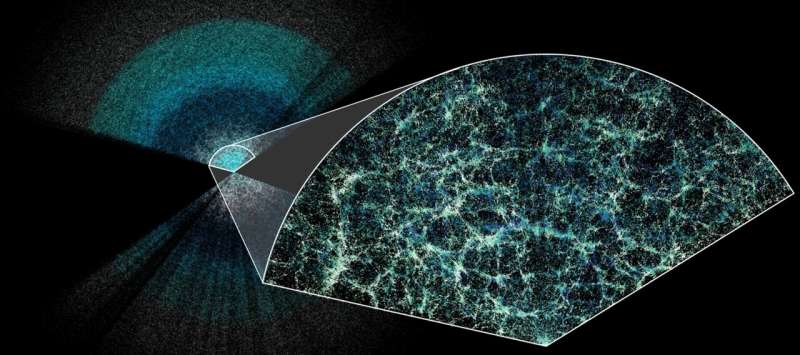
Illustration of three-dimensional galaxy positions from DESI data (i.e. including galaxy distances determined using spectroscopic redshift measurement). Credit: DESI
A team from Ludwig Maximilian University (LMU) has provided a model to reveal what the colour of a galaxy reveals about its distance, in order to use it to measure cosmic structures.
Our universe is about 13.8 billion years old. During this time, the smallest initial asymmetries have transformed into large-scale structures that we can observe through our telescopes in the night sky: galaxies like our own Milky Way, galaxy clusters, and even larger clumps of matter or filaments of gas and dust.
How fast this growth will happen depends, at least in the current universe, on a kind of struggle between natural forces: can dark matter, which holds everything together with its gravity and attracts additional matter, stand up to dark energy, which is pushing the universe further and further apart?
“If we can precisely measure the structures in the sky, then we can observe this struggle,” says LMU astrophysicist Daniel Grün.
This is where telescopic observation projects come in, which make it possible to capture large areas of the sky with great precision. Examples include the Dark Energy Survey with the Blanco telescope in Chile and the recently commissioned Euclid satellite. LMU scientists have been involved in both projects for years, including in leadership positions.
The largest dataset evaluated to date
It is not always easy to determine the precise distance between different structures and galaxies, but this step is of vital importance. Indeed, the further away a galaxy is, the more time its light has traveled to reach us, and the image of the universe that its observation reveals to us is therefore older. The observed color of a galaxy is an important source of information. It is measured by terrestrial telescopes like Blanco or satellites like Euclid.
A new study by a team led by Jamie McCullough and Daniel Grün, published in the journal Monthly Notices of the Royal Astronomical Societyanalyzed the largest dataset to date and sheds light on what the color of various galaxies actually says about their true distance.
In principle, the distance of a galaxy can be determined precisely using spectroscopy. To do this, the spectral lines of distant galaxies are measured. Since the universe as a whole is expanding, these appear to have a longer wavelength the further away the galaxy is from us. This is because the light waves from distant galaxies become longer during the long journey to us.
This effect, known as redshift, also changes the apparent colors measured by instruments in the image of the galaxy. They appear redder than they actually are. This is similar to the Doppler effect heard in the apparent sound of an ambulance siren as it passes us and moves away.
No two galaxies are the same
Jamie McCullough is a PhD student at LMU and Stanford University. For her analysis, she used spectroscopic measurements from the Dark Energy Spectroscopic Instrument (DESI) in conjunction with the largest dataset to date for precise measurement of galaxy colors (KiDS-VIKING).
Specifically, the authors combined DESI spectroscopic data on a total of 230,000 galaxies with the colors of those galaxies in the KiDS-VIKING study and used this information to determine the relationship between a galaxy’s distance from us and its observed color and brightness. No two galaxies in the universe are the same, but for each class of similar galaxies, there is a particular relationship between observed color and redshift.
“If we can combine distance information with measurements of the shape of galaxies, we can infer large-scale structures from the light distortions,” says Jamie McCullough.
The results of the study make it possible to statistically determine the real distance of each galaxy observed in images taken by Euclid or the Dark Energy Survey.
By analyzing the distortions observed in galaxy images, scientists will be able to learn more about the behavior of cosmic structures today and billions of years ago and better understand them. This will allow them to better understand the evolutionary history of the universe.
To be able to observe the evolution of the formation of structures over time, it is not necessary to wait billions of years: it is enough to measure the structure at different distances from Earth. With images alone, this is almost impossible, because one cannot simply determine the distance of a galaxy from ours from its appearance in an image.
Jamie McCullough’s study holds the key to this problem by providing a model of what the apparent “color” of a galaxy tells us about its distance from us.
Observing the struggle between dark matter and dark energy
The main goal of this precise observation and distribution of galaxies at different distances is to better understand the great battle between the natural forces of dark matter and dark energy.
“To really see what’s going on, you have to be able to look at the individual rounds of this match,” Grün says. That’s because dark energy is about to catch up and potentially completely stop the formation of larger accumulations of mass in the universe.
“Only then will we understand what dark matter and dark energy really are, and which of them will ultimately prevail.”
More information:
J McCullough et al, DESI full calibration of the color-redshift relationship (DC3R2): results from the first DESI data, Monthly Notices of the Royal Astronomical Society (2024). DOI: 10.1093/mnras/stae1316
Provided by Ludwig Maximilian University of Munich
Quote:Cosmic Wrestling Match: New Model Reveals What a Galaxy’s Color Reveals About Its Distance (2024, July 15) Retrieved July 16, 2024, from https://phys.org/news/2024-07-cosmic-reveals-galaxy-distance.html
This document is subject to copyright. Apart from any fair dealing for the purpose of private study or research, no part may be reproduced without written permission. The content is provided for informational purposes only.